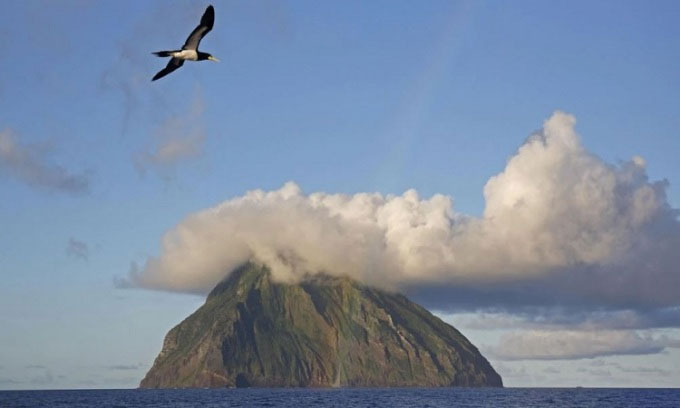If confirmed, the tremor at a depth of 751 km could surprise geologists who believed that earthquakes were nearly impossible in the mantle.
On a spring evening six years ago, hundreds of kilometers beneath the Earth’s surface began to vibrate due to a series of unusual earthquakes. Most earthquakes on Earth occur within a few dozen kilometers below the planet’s surface, but these quakes appeared at depths where temperature and pressure are so high that rocks bend rather than break. The first recorded earthquake occurred off the remote Bonin Islands of Japan, measuring 7.9 in magnitude and located at a depth of 680 km. This was followed by the deepest earthquake ever discovered.

The earthquake occurred hundreds of kilometers below the Bonin Islands. (Photo: Alamy)
The super-deep earthquake recently described in the journal Geophysical Research Letters is estimated to have occurred at a depth of 751 km beneath the Earth’s surface in the mantle. Researchers have long believed that earthquakes are unlikely or impossible to occur there. Although there is some evidence of earthquakes in the mantle from previous studies, researchers still struggle to pinpoint their locations. “This is the clearest evidence of an earthquake in the mantle to date,” said Douglas Wiens, a seismologist specializing in deep earthquakes at Washington University in St. Louis.
Some scientists believe further research is needed to confirm that this earthquake is real and occurred in the mantle. Although the average boundary of the mantle is 660 km below the surface, there are many variations globally. Beneath Japan, the mantle is thought to begin at a depth of 700 km. The research team has previously detected several aftershocks around this depth.
While deep earthquakes do not cause damage like shallow earthquakes, studying these events can help scientists determine movements beneath the surface, revealing the Earth’s internal structure. Earthquakes in the mantle are very rare and may occur under specific conditions, according to Heidi Houston, a geophysicist and deep earthquake expert at the University of Southern California.
The 7.9 magnitude earthquake itself is quite unusual. People across all 47 prefectures of Japan reported feeling the earthquake, the first time in over 130 years. The vast majority of earthquakes occur relatively shallow. Out of 56,832 recorded earthquakes from moderate to large between 1976 and 2020, only 18% occurred at depths greater than 70 km. Only 4% were concentrated at depths below 300 km.
For nearly a century, since British astronomer and seismologist Herbert Hall Turner discovered the first deep earthquake in 1922, researchers have been puzzled about how such earthquakes occur. Near the surface, the slow movement of tectonic plates builds pressure until the ground fractures and shifts, generating tremors. However, deep within the Earth, high pressure prevents similar vibrations. Combined with extreme temperatures, rocks behave more like mortar than solid blocks, according to Magali Billen, a geodynamicist at the University of California, Davis.
To explore this issue, seismologist Eric Kiser at the University of Arizona and colleagues took a closer look at the large earthquake beneath the Bonin Islands. Seismometers around the world, including Japan’s Hi-Net network, recorded signals from this earthquake. The research team examined Hi-Net data to search for aftershocks. A significant event like this would transmit energy continuously through the near-surface layers, overshadowing smaller aftershocks. To amplify the small signals amidst all the noise, the researchers used a method called back-projection, which allows them to stack data from multiple seismometers. They discovered four aftershocks at depths of 695 – 715 km and one earthquake at a depth of 751 km from the surface.
All deep earthquakes occur near modern or ancient subduction zones, where tectonic plates collide, causing one plate to sink beneath another. Changes in the subducting plate as it plunges to great depths likely trigger vibrations deep beneath the surface. However, scientists remain uncertain about the process that accumulates pressure high enough to cause deep earthquakes. The answer may lie in phenomena that cause layering in the mantle.
The upper mantle is filled with shimmering green olivine minerals. However, at greater depths, the crystal structure of these minerals becomes unstable. Starting from 410 km, atoms can rearrange into the minerals wadsleyite or ringwoodite. The transformation of olivine within the mantle may create many weaknesses in the rocks, allowing them to deform rapidly, resulting in deep earthquakes.
However, below 660 km, the system changes dramatically. Seismic waves around this boundary indicate that the rocks below are much denser than those above. Here, the earth-colored bridgmanite minerals dominate. The transformation that causes earthquakes from olivine no longer occurs as in the upper layers. Therefore, earthquakes in this layer are certainly caused by something else.
One possibility is the transformation of another type of mineral within the subducting tectonic plate, such as the reddish-brown enstatite mineral. However, Kiser and colleagues discovered another plausible cause stemming from the movement of tectonic plates. The small aftershocks following the 7.9 magnitude earthquake occurred near the base of the tectonic plate at the bottom of the Pacific Ocean. The research team suggests that the large earthquake may have caused a part of the tectonic plate to shift. This slight movement could concentrate pressure at the base of the tectonic plate as it sinks deeper into the denser mantle. Scientists will need to analyze further and model the structure of the subducting plate alongside the aftershock locations of the 7.9 magnitude earthquake to determine the mechanisms of deep earthquakes.


















































